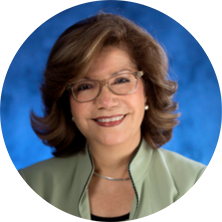By Dina Castro, PhD, MPH
The goal of education is to give all children the opportunity to develop their potential, and that begins from early childhood. For children of immigrant families who are developing in two languages, a quality education is one that celebrates both their bilingualism and their culture, and incorporates them into the teaching.
Bilingualism in immigrant families
Bilingual children think and learn different things in each language, some at home with their families and others at school or in their community. When children are asked to speak only English, whether at school or at home, they can lose verbal skills in their first language and the advantages that being bilingual provides them in the learning process. When they are not allowed to use their first language, communication with their parents and other relatives who speak only Spanish may diminish. In the long term, this can distance them from their family and culture, affecting their identity, self-esteem and the attachments they need to grow up healthy and happy.
“It doesn’t bother me that my son doesn’t speak to me in Spanish, because I know he understands what I say to him.”
I have heard this comment from some immigrant parents who decide not to insist that their children speak Spanish. Though children may understand what we tell them, it is very important for them to speak Spanish too, because if they don’t, little by little, they might gradually lose it, especially when they’re young and their Spanish fluency is limited. Talking and reading in Spanish, children will learn new words and ways to use them.
Parents may sometimes decide not to support their children in speaking Spanish because they want them to be successful in the United States or because they want to prevent their children from being discriminated against. These ideas may be related to their own negative experiences. It’s unfortunate that some people have gone through these kinds of experiences, but the decision to discourage bilingualism in their children is not the solution. On the contrary, we need to strengthen our community and make our children feel proud of their culture and their Spanish language. With this strength, they can become bilingual and bicultural people capable of developing all of their talents and fulfilling their potential.
“What if the day comes when I can’t talk with my grandchildren?”
My mother asked me this question with tears in her eyes, when my five-year-old, whom she had raised, was starting to have difficulty speaking in Spanish when we would call her on the phone in Peru. By the end of kindergarten, in a school where only English was spoken, my son had started to forget Spanish. After this incident it took years of dedication and discipline at home and in collaboration with his teachers for my son to finish elementary school able to read and write in Spanish. Afterwards, in high school he took advanced grammar and Latin American and Spanish literature classes. At the same time we were trying to get him to learn Spanish, he took French courses at school and eventually became trilingual. We were able to do this even though at that time there were no bilingual education programs in our community. Today the number of Spanish/English bilingual education programs is on the rise, which is a great opportunity for immigrant families who want their children to be bilingual.
From research on bilingualism, we know that:
- Bilingual children’s development is different from development in children who speak only one language (monolingual). Their brains work differently because they use both languages all the time.
- From birth, children have the capacity to learn more than one language; it doesn’t confuse them or hinder their learning of English.
- Bilingualism has no negative consequences for child development. On the contrary, it’s beneficial to cognitive, linguistic, social and emotional development.
- Advanced Spanish skills make it easier to learn English. When development of the Spanish language is interrupted, it becomes harder to learn English.
- Bilingual children who attend bilingual schools usually have better grades than those who live in bilingual families and communities but attend English-only schools.
What does this mean for early childhood education?
School programs should support the development of children who are bilingual. Since these children are learning in two languages, it’s important to ask for all of their evaluations to be done in both Spanish and English. It’s also important for us to seek out preschool programs with bilingual teachers who teach in Spanish and English. If there are no bilingual preschool programs in our communities, we can look for schools that teach in English using Spanish as a backup. In those cases, the participation of parents and other family members takes on even greater importance in our children’s learning of Spanish. For example, we might collaborate as volunteers at school to read or tell stories in Spanish. Your children will love seeing you at school and it will make them feel important. And of course, we need to keep on reading, singing and talking a lot of Spanish at home.
Remember,
- There’s no reason to believe that children who grow up with two languages will fall behind at school or in language development. They really just need constant support in order to take advantage of the opportunity to be bilingual.
- Children need to practice Spanish by talking, reading and writing it, in addition to hearing Spanish, so that they can become competent in managing the language.
- Being born into a family where a language other than English is spoken is ideal for becoming bilingual. Moreover, the mother tongue – the one we hear from our mothers before we’re born, is the one babies use to establish their first emotional bonds.
- Being aware of the enormous benefit of being bilingual, we should advocate for more bilingual programs and foster bilingualism at home and in our communities.



